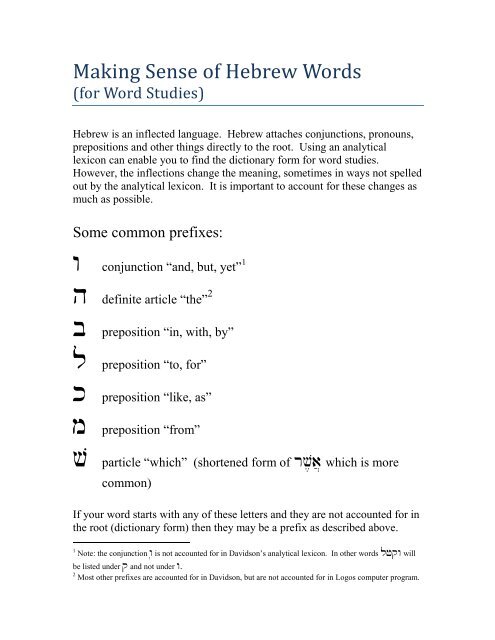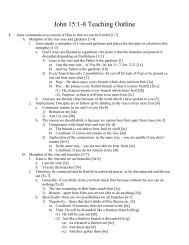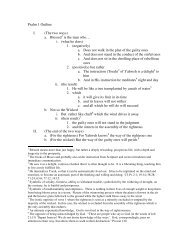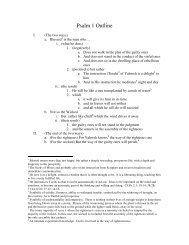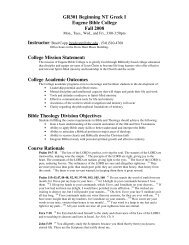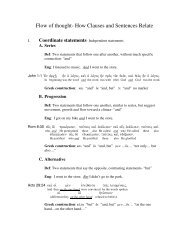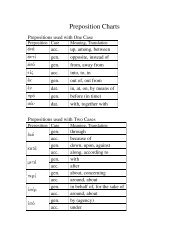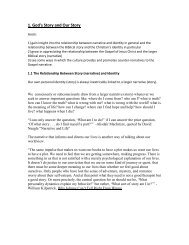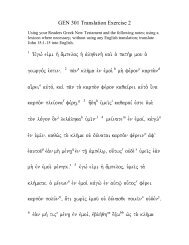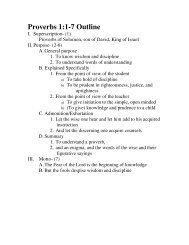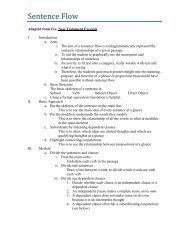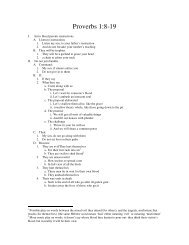Word Inflections - Bradcopp.com
Word Inflections - Bradcopp.com
Word Inflections - Bradcopp.com
You also want an ePaper? Increase the reach of your titles
YUMPU automatically turns print PDFs into web optimized ePapers that Google loves.
Making Sense of Hebrew <strong>Word</strong>s<br />
(for <strong>Word</strong> Studies)<br />
Hebrew is an inflected language. Hebrew attaches conjunctions, pronouns,<br />
prepositions and other things directly to the root. Using an analytical<br />
lexicon can enable you to find the dictionary form for word studies.<br />
However, the inflections change the meaning, sometimes in ways not spelled<br />
out by the analytical lexicon. It is important to account for these changes as<br />
much as possible.<br />
Some <strong>com</strong>mon prefixes:<br />
w conjunction “and, but, yet” 1<br />
h definite article “the” 2<br />
b preposition “in, with, by”<br />
l preposition “to, for”<br />
k preposition “like, as”<br />
m preposition “from”<br />
v particle “which” (shortened form of rv,a] which is more<br />
<strong>com</strong>mon)<br />
If your word starts with any of these letters and they are not accounted for in<br />
the root (dictionary form) then they may be a prefix as described above.<br />
1 Note: the conjunction w. is not accounted for in Davidson‟s analytical lexicon. In other words ljqw will<br />
be listed under q and not under w.<br />
2 Most other prefixes are accounted for in Davidson, but are not accounted for in Logos <strong>com</strong>puter program.
The pronominal Suffixes<br />
Person, Gender,<br />
Number<br />
Basic Form<br />
of Suffix<br />
Suffix with<br />
Preposit. l<br />
Suffix with<br />
noun sWs<br />
Suffix with<br />
verb lj;q'<br />
'<br />
1 st <strong>com</strong>m sing ynI yli ysiWs ynIl;j'q.<br />
2 nd masc sing ^ ^l. ^s.Ws ^l.j'q.<br />
2 nd fem sing % %l' %seWs %lej'q.<br />
3 rd masc sing A Wh Al AsWs Alj'q.<br />
3 rd fem sing H h' Hl' Hs'Ws Hl'j'q.<br />
1 st <strong>com</strong>m pl Wn Wnl' WnseWs Wnl'j'q.<br />
2 nd masc pl ~k, ~k,l' ~k,s.Ws ~k,l.j'q.<br />
2 nd fem pl !k, !k,l' !k,s.Ws !k,l.j'q.<br />
3 rd mas pl ~ ~h,l' ~s'Ws ~l'j'q.<br />
3 rd fem pl ! !h,l' !s'Ws !l'j'q.
Verbs:<br />
Verbs inflect for person, gender and number of the subject. In Hebrew, the<br />
inflections are represented by either prefixes or suffixes or both. The<br />
suffixes are too <strong>com</strong>plicated to be covered here, and can be easily confused<br />
with pronominal suffixes. However, an analytical lexicon will tell you the<br />
inflection of the verb and the presence of pronominal suffixes. There are<br />
only four letters that are ever prefixed as part of a basic verb inflection. 3<br />
These are y t a and n . If you see one of these letters prefixed to a verb<br />
and you cannot account for them, assume they are part of the inflection.<br />
Hebrew Verb Stems<br />
In Hebrew, like in Greek, inflection of verbs can drastically alter the<br />
meaning.<br />
For example:<br />
lj;q'<br />
lj;q.nI<br />
ljeqi<br />
lyjiq.hi<br />
“he killed”<br />
“he was killed”<br />
“he slaughtered”<br />
“he caused to kill”<br />
Hebrew makes these types of changes by changing internal vowels and some<br />
prefixes. These spelling patterns are regular and are grouped into what are<br />
called „stems‟.<br />
3 The letter m is sometimes prefixed as a marker of a participle in the derived stems (see below).
The basic form is called Qal (Hebrew for „light‟ (opp. of „heavy‟)).<br />
The other forms get their name from the <strong>com</strong>mon verb l[p .<br />
Stem name 4<br />
Qal<br />
Niphal<br />
Vowel pattern<br />
l[;P'<br />
l[;p.nI<br />
Piel l[ePi 5<br />
Pual<br />
Hiphil<br />
Hophal<br />
Hithpael<br />
l[;Pu<br />
ly[ip.hi<br />
l[;p.h'<br />
l[eP;t.hi<br />
4 There are seven basic stems, listed here. There are also a number of less <strong>com</strong>mon stems with irregular<br />
verbs. The analytical lexicon will give you enough information to find these words in the BDB lexicon<br />
5 The second letter (radical) of the Piel, Pual and Hithpael stems is usually doubled with a dagesh.<br />
However, the second letter in this word is a gutteral, which does not double with a dagesh.
Each stem has a distinctive translation value. The exact value is<br />
debated by scholars, but some general trends are discernable.<br />
Qal is basic active meaning<br />
rb;v' he broke<br />
Niphal is often passive<br />
rb;v.nI he was broken<br />
Piel may be intensive<br />
rBevi he shattered, smashed<br />
Pual is the passive of piel<br />
rB;vu he was shattered, smashed<br />
Hiphil has a causative idea<br />
rybiv.hi he caused to break out<br />
Hophal is the passive of hiphil<br />
rb;v.h' he was caused to break out<br />
Hithpael is often reflexive<br />
rbev;t.hi he broke himself<br />
***However, these basic translation values are not always<br />
accurate. The best approach is to treat each stem as a different<br />
word. That is why the Lexicons list each stem separately. The<br />
definition for one stem is not a valid definition for the same word<br />
in a different stem.***<br />
One final concept:<br />
Intransitive verbs do not have a direct object. “I ran.”<br />
Transitive verbs have a direct object. “I ran the race.”<br />
The same verb may be both transitive and intransitive at different<br />
times (like „ran‟). But in Hebrew, often the transitive meaning is<br />
different from the intransitive.<br />
Be careful to note whether a verb is transitive or intransitive,<br />
especially if the Lexicon has a different definition for each<br />
occasion.


